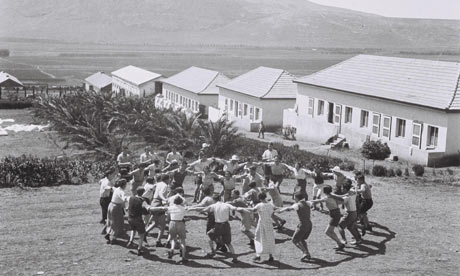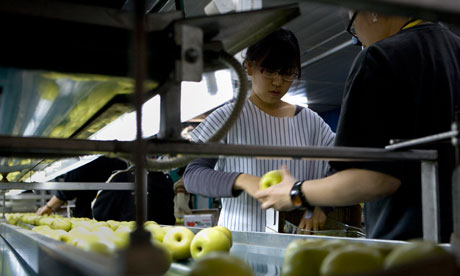The kibbutz: 100 years old and facing an uncertain future
In 1910, the first kibbutz was founded on strongly Zionist socialist principles. One hundred years later, the movement is still holding on. But can it survive in a globalised world?
-

-
- The Guardian, Friday 13 August 2010

Reggie Pearlson clutched the tiny bundle close. She and her newborn son were travelling in a lorry from hospital back to the embryonic kibbutz close to the Sea of Galilee in northern Israel.
The year was 1960, and Reggie was a recent arrival from England to join a nucleus of determined pioneers, intent on building both their vision of a communal way of life and the fledgling state of Israel, declared 12 years earlier – the same year that Kibbutz Kfar Hanasi was founded.
The lorry driver dropped Reggie and her infant outside the baby house, where mother and son parted company. "I was told I could come back at 4pm to feed him," she says today.
Kfar Hanasi, in common with most kibbutzim at the time, separated children from their parents to allow the adults to realise the socialist dream unhampered by their demands. Youngsters were raised in a socialised environment, inculcating in them the ideology of collectivism on which the kibbutz movement was founded.
"In England, before I came, I thought the idea of children being separated sounded wonderful – I would be able to contribute more," recalls Reggie, now 73, and still living at Kfar Hanasi. "But as soon as I had my first child, I realised it was a terrible mistake. I cried for about a year and a half."
Reggie saw her firstborn every few hours while she was breastfeeding. Six weeks after the birth, she was allocated the job of cleaning the communal toilets. "It was a job given to feeding mothers because you could fit it round the baby," she says. Reggie went on to have a further five children – "it was the only way I could get over the separation, to keep having another." Soon after she joined, the kibbutz voted to halt family separation but it took five years to build family units that would allow parents and children to sleep under one roof. "So we had to sit it out," she says.
It was the first of many agonised reviews of founding principles, both at Kfar Hanasi and at kibbutzim all over Israel. As the movement prepares to celebrate its centenary this October, some are asking if, despite the reforms and adaptations, this unique form of collective living is facing an existential crisis in a globalised, market-driven, individualist world.
The kibbutz – literally a "gathering" in Hebrew – was not just a utopian, collective way of life, but also a Zionist project. Settling and developing the land were stepping stones to a Jewish state, and the muscular, youthful kibbutznik played a significant military role in the war that followed the 1948 declaration of the state of Israel. The kibbutz movement has always been a largely secular one; even today only 16 kibbutzim define themselves as religious.
Today, of the 273 kibbutzim in Israel, only about 60 still operate on a truly communal basis, in which all members are paid the same basic sum whatever their work, with services provided by the collective. Most of the rest have introduced reforms in response to what the Kibbutz movement calls "a severe socio-economic crisis [that] threatened the future of numerous kibbutzim – they owed huge debts to the banks and thousands of young people were leaving the communities. The kibbutzim were in danger of falling apart."
The principal reforms were to introduce differential wages and privatise some of the services. It was not an easy process. George Ney, 74, who has lived at Kfar Hanasi for almost 50 years, recalls in a memoir: "It was a long, slow process, whose milestones were intense and sometimes bitter discussions. The embers of our idealism haven't died out, and we even have a few firebrands still, but today I think there is little doubt that the side of the individual outweighs the one of the community."
At Kfar Hanasi, the debate began in earnest when, in the early 1980s, the kibbutz discovered it was bankrupt. "We weren't earning enough to cover our standard of living," Ney says now, recalling people who left electric fires on all day when they were at work because they were not responsible for individual bills. "No one ever said you can't have three eggs for breakfast," says Pearlson. An exodus of young people – "the cream of the kibbutz," according to Pearlson – contributed to the crisis, tipping the demographic balance towards the elderly.
The reforms included making individual members pay for services such as electricity, telephones, postage and laundry out of an allowance. The communal dining room – previously the heart of the kibbutz – which had served three free meals a day, introduced charges and eventually closed. Previously, the slogan had been "whatever the kibbutz decides"; now it became "personal choice", according to Ney's memoir.
But the "earthquake" was the introduction of differential wages. It turned the kibbutz philosophy on its head. "The jobs we once thought were the elite jobs – physical work in the fields and orchards – turned out to pay the least," recalls Ney. Managers were paid more than labourers, and productivity was rewarded. The kibbutz factory was sold to a private investor, a bed and breakfast enterprise to attract tourists was launched.
Other kibbutzim around Israel were facing their own earthquakes. Degania Aleph, the first kibbutz to be established in, October 1910, and where the centenary celebrations will take place in the autumn, voted three and a half years ago to partially privatise itself. It was a hugely symbolic moment. Founded by a dozen pioneers from eastern Europe on the southern shores of the Sea of Galilee on land bought from Bedouin Arabs, Degania now has a population of 750, although fewer than half are full members of the co-operative. Its income is based on agriculture – bananas, dates, olives, avocados and mangoes, plus chickens and dairy cows; a diamond-cutting factory; and income from kibbutz members who work outside and pay their salaries into a collective fund.
The members receive an allowance based on their jobs, although the differential between the lowest and highest paid is capped at around 25%. The kibbutz provides housing, health, education and all community services. "We wanted to keep the old idea of the collective but also to be connected to the outside world," says Shay Shoshany, Degania's elected chairman. Ninety-five per cent of the members voted in favour of the reforms, he says. "The world around us has changed, and we can't be an island."
The non-members who live at Degania pay rent and for services but have no voting rights. They can apply to become members after two years.
Shoshany insists that the reforms at Degania have guaranteed the future of the movement. "In the last three years, the population of Israel's kibbutzim has risen, and the average age come down. In my view, it's because of the reforms. People see the kibbutz as an attractive, secure place to live – we are not prisoners of the past.
"I feel like one of the last real socialists left in the world. I'm very proud to live in a society that still sees solidarity as important. But I don't want to stay stuck in the past. I don't want Degania to be like an Indian reservation or an Amish community. We need to be connected with the society around us."

Other kibbutzim are holding firm to the collective ideal, where everyone is paid the same regardless of what they do. At Kibbutz Ba'ram, a few kilometres from the Lebanese border, 90% of the community still take three meals a day in the communal dining room, where the food is excellent and free. Raviv Gutman, 42, was born at Ba'ram, left for seven years and returned 12 years ago. There has been some change, he concedes, citing the fact that cigarettes and televisions are no longer distributed free.
To an outsider, it seems a model of collective living. Everything from nappies to piano lessons are provided for children; there are 100 communal cars that members can book on the kibbutz intranet; jobs are allocated by a committee; there is a gym, a swimming pool, a theatre showing movies and shows, even a kibbutz pub that opens two evenings a week. Members who choose to work outside the kibbutz pay their entire salary into a central fund. Even the climate is good. "We don't have a problem with people leaving [the kibbutz]," says Gutman. "Why would you want to leave? People have a good life here."
There is only one moment when Gutman's evangelism falters: when asked what it was like to live away from his parents, in a children's house – a policy not abandoned at Ba'ram until the late 90s. "Until I got married, I thought it was great – we were independent, all kids together. But now I have lots of problems stemming from this time. I think that kids need to be with their parents. I realised this very late. When I became a father and saw my baby growing up, I began to feel each moment that I had missed. But that was the way of life then. Maybe it was good, but we paid a price for it for sure."
The separation policy was introduced because "there was no choice," insists Amran Biran, 79, who arrived at Ba'ram from Switzerland at the age of 26. "We had to have that system – men and women both had to work equally to build the kibbutz." Lingering over fragile black-and-white photographs, Biran recalls those days. "We were poor then, there wasn't the luxury you see now. At the beginning we lived in wooden barracks, with outside facilities. Even pregnant women had to walk through the snow and mud in the winter to use the toilets. We worked hard, it was a very primitive life."
Biran did a variety of jobs on the kibbutz, including groundsman, plumber and postman. But his first role was unusual. "I was a pig-breeder. We ate pork in those days. These were happy times – the rabbis didn't have as much power as they do now." Now he spends his days visiting the kibbutz club for the elderly, talking to visitors and volunteers, and patrolling the paved pathways in his battery-operated golf cart.
Although he says it was "just a windbeaten stony hill" when the first 29 kibbutzniks arrived in 1949, Ba'ram was built on the site of a Christian Arab village whose inhabitants were forced out in the 1948 war. It was a "real communist life" in the early days, Biran says. "The kibbutz of today is not the same." And it may be about to change further.
"People are beginning to say they should be paid according to what they do," says Gutman. "When I came back 12 years ago, I thought it would happen within 10 years. It hasn't yet, but it will for sure."
The kibbutzim that have privatised and reformed insist it is a mechanism for keeping the flame of collectivism alight, rather than a rejection of the old ideals. Kfar Hanasi is now looking forward to a modest influx of new members – 20 are soon to join the existing 250. "It's not a revival, but the kibbutz will survive," says Pearlson. And at Israel's original kibbutz, Shoshani agrees: "The kibbutz of today is not the same as the one established 100 years ago. But if we could ask the original pioneers what they think of today's kibbutz, maybe they would say it's better than their dream.
"I don't want to stay in the romantic picture of the kibbutz. I want this community to continue to live – I want to see young families, a horizon, a future. If we stay stuck in the past without change, I'm not sure we can celebrate another 100-year anniversary."